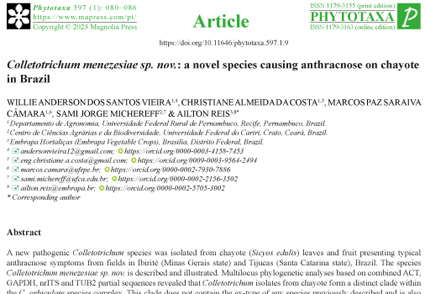Abstract
A new pathogenic Colletotrichum species was isolated from chayote (Sicyos edulis) leaves and fruit presenting typical anthracnose symptoms from fields in Ibirité (Minas Gerais state) and Tijucas (Santa Catarina state), Brazil. The species Colletotrichum menezesiae sp. nov. is described and illustrated. Multilocus phylogenetic analyses based on combined ACT, GAPDH, nrITS and TUB2 partial sequences revealed that Colletotrichum isolates from chayote form a distinct clade within the C. orbiculare species complex. This clade does not contain the ex-type of any species previously described and is also recognized as an independent lineage according to the GCPSR criteria.
References
Carbone, I. & Kohn, L.M. (1999) A method for designing primer sets for speciation studies in filamentous ascomycetes. Mycologia 91: 553–556. https://doi.org/10.1080/00275514.1999.12061051
Coronel, O.A.D.Á., León-García, E., Vela-Gutiérrez, G., Medina, J.D. la C., García-Varela, R. & García, H.S. (2017) Chayote (Sechium edule (Jacq.) Swartz). In: Yahia, E.M. (ed.) Fruit and Vegetable Phytochemicals. John Wiley & Sons, Chichester, UK, pp. 979–992.
Damm, U., Cannon, P.F., Liu, F., Barreto, R.W., Guatimosim, E. & Crous, P.W. (2013) The Colletotrichum orbiculare species complex: important pathogens of field crops and weeds. Fungal Diversity 61: 29–59. https://doi.org/10.1007/s13225-013-0255-4
Damm, U., Sato, T., Alizadeh, A., Groenewald, J.Z. & Crous, P.W. (2019) The Colletotrichum dracaenophilum, C. magnum and C. orchidearum species complexes. Studies in Mycology 92: 1–46. https://doi.org/10.1016/j.simyco.2018.04.001
Dettman, J.R., Jacobson, D.J., Turner, E., Pringle, A. & Taylor, J.W. (2003) Reproductive isolation and phylogenetic divergence in Neurospora: comparing methods of species recognition in a model eukaryote. Evolution 57: 2721–2741. https://doi.org/10.1111/j.0014-3820.2003.tb01515.x
Díaz-de-Cerio, E., Verardo, V., Fernández-Gutiérrez, A. & Gómez-Caravaca, A.M. (2019) New insight into phenolic composition of chayote (Sechium edule (Jacq.) Sw.). Food Chemistry 295: 514–519. https://doi.org/10.1016/j.foodchem.2019.05.146
Farr, D.F. & Rossman, A.Y. (2023) Fungal Databases, U.S. National Fungus Collections, ARS, USDA. [https://nt.ars-grin.gov/fungaldatabases]
Gardes, M. & Bruns, T.D. (1993) ITS primers with enhanced specificity for basidiomycetes - application to the identification of mycorrhizae and rusts. Molecular Ecology 2: 113–118. https://doi.org/10.1111/j.1365-294X.1993.tb00005.x
Glass, N.L. & Donaldson, G.C. (1995) Development of primer sets designed for use with the PCR to amplify conserved genes from filamentous ascomycetes. Applied and Environmental Microbiology 61: 1323–1330. https://doi.org/10.1128/aem.61.4.1323-1330.1995
Johnston, P.R. & Jones, D. (1997) Relationships among Colletotrichum isolates from fruit-rots assessed using rDNA sequences. Mycologia 89: 420–430. https://doi.org/10.1080/00275514.1997.12026801
Kalyaanamoorthy, S., Minh, B.Q., Wong, T.K.F., von Haeseler, A. & Jermiin, L.S. (2017) ModelFinder: fast model selection for accurate phylogenetic estimates. Nature Methods 14: 587–589. https://doi.org/10.1038/nmeth.4285
Katoh, K., Rozewicki, J. & Yamada, K.D. (2019) MAFFT online service: multiple sequence alignment, interactive sequence choice and visualization. Briefings in Bioinformatics 20: 1160–1166. https://doi.org/10.1093/bib/bbx108
Kumar, S., Stecher, G. & Tamura, K. (2016) MEGA7: Molecular evolutionary genetics analysis version 7.0 for bigger datasets. Molecular Biology and Evolution 33: 1870–1874. https://doi.org/10.1093/molbev/msw054
Kuraku, S., Zmasek, C.M., Nishimura, O. & Katoh, K. (2013) aLeaves facilitates on-demand exploration of metazoan gene family trees on MAFFT sequence alignment server with enhanced interactivity. Nucleic Acids Research 41: W22–W28. https://doi.org/10.1093/nar/gkt389
Minh, B.Q., Schmidt, H.A., Chernomor, O., Schrempf, D., Woodhams, M.D., von Haeseler, A. & Lanfear, R. (2020) IQ-TREE 2: new models and efficient methods for phylogenetic inference in the genomic era. Molecular Biology and Evolution 37: 1530–1534. https://doi.org/10.1093/molbev/msaa015
Nguyen, L.-T., Schmidt, H.A., von Haeseler, A. & Minh, B.Q. (2015) IQ-TREE: a fast and effective stochastic algorithm for estimating maximum-likelihood phylogenies. Molecular Biology and Evolution 32: 268–274. https://doi.org/10.1093/molbev/msu300
Noireung, P., Phoulivong, S., Liu, F., Cai, L., McKenzie, E.H.C., Chukeatirote, E., Jones, E.B.G., Bahkali, A.H. & Hyde, K.D. (2012) Novel species of Colletotrichum revealed by morphology and molecular analysis. Cryptogamie, Mycologie 33: 347–362. https://doi.org/10.7872/crym.v33.iss3.2012.347
Nylander, J.A.A. (2004) MrModeltest v2. Program distributed by the author. Evolutionary Biology Centre, Uppsala University, Uppsala, Sweden.
O’Donnell, K. & Cigelnik, E. (1997) Two divergent intragenomic rDNA ITS2 types within a monophyletic lineage of the fungus Fusarium are nonorthologous. Molecular Phylogenetics and Evolution 7: 103–116. https://doi.org/10.1006/mpev.1996.0376
Oliveira, J.T. de & Oliveira, R.A. de (2021) Path analysis of physical attributes of chayote fruit. Engenharia Agrícola 41: 468–474. https://doi.org/10.1590/1809-4430-eng.agric.v41n4p468-474/2021
Rambaut, A., Drummond, A.J., Xie, D., Baele, G. & Suchard, M.A. (2018) Posterior summarization in Bayesian phylogenetics using tracer 1.7. Systematic Biology 67: 901–904. https://doi.org/10.1093/sysbio/syy032
Shimodaira, H. (2002) An approximately unbiased test of phylogenetic tree selection. Systematic Biology 51: 492–508. https://doi.org/10.1080/10635150290069913
Staden, R., Beal, K.F. & Bonfield, J.K. (1999) The Staden package, 1998. In: Bioinformatics Methods and Protocols. Humana Press, New Jersey, pp. 115–130.
Taylor, J.W., Jacobson, D.J., Kroken, S., Kasuga, T., Geiser, D.M., Hibbett, D.S. & Fisher, M.C. (2000) Phylogenetic species recognition and species concepts in fungi. Fungal Genetics and Biology 31: 21–32. https://doi.org/10.1006/fgbi.2000.1228
Templeton, D., Rikkerink, E.H.A., Solon, S.L. & Crowhurst, R.N. (1992) Characterization of the glyceraldehyde-3-phosphate gene and cDNA from the plant pathogenic fungus. Mycologia 122: 225–230. https://doi.org/10.1016/0378-1119(92)90055-T
Vaidya, G., Lohman, D.J. & Meier, R. (2011) SequenceMatrix: concatenation software for the fast assembly of multi-gene datasets with character set and codon information. Cladistics 27: 171–180. https://doi.org/10.1111/j.1096-0031.2010.00329.x
Vieira, W.A.S., Lima, W.G., Nascimento, E.S., Michereff, S.J., Câmara, M.P.S. & Doyle, V.P. (2017) The impact of phenotypic and molecular data on the inference of Colletotrichum diversity associated with Musa. Mycologia 109: 912–934. https://doi.org/10.1080/00275514.2017.1418577
White, T.J., Bruns, T., Lee, S. & Taylor, J. (1990) Amplification and direct sequencing of fungal ribosomal RNA genes for phylogenetics. In: PCR Protocols. Elsevier, pp. 315–322. https://doi.org/10.1016/B978-0-12-372180-8.50042-1


